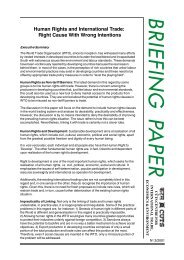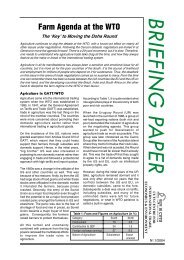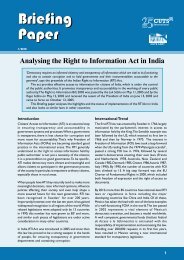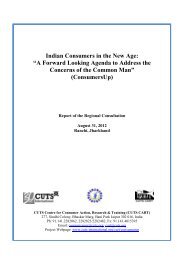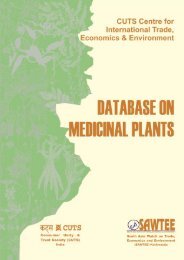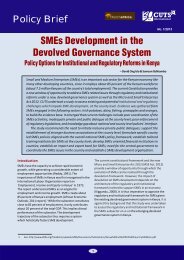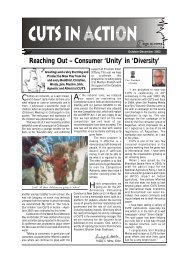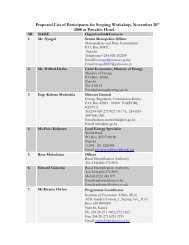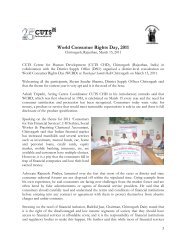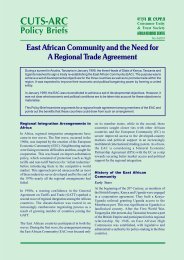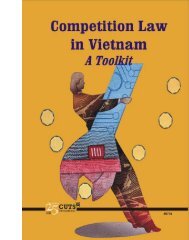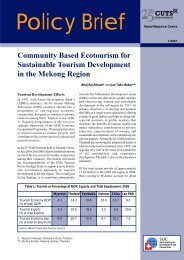Final Report - World Trade Organization
Final Report - World Trade Organization
Final Report - World Trade Organization
Create successful ePaper yourself
Turn your PDF publications into a flip-book with our unique Google optimized e-Paper software.
dominance’ investigations, focusing the investigations<br />
on a specific segment of firms. The <strong>World</strong> Bank-<br />
OECD model law suggests a threshold of 35 percent<br />
while the UNCTAD Model Law is silent in this<br />
regard.<br />
Abuse<br />
After determining that an enterprise has a dominant<br />
position of market power, the question is whether or<br />
not this enterprise is ‘abusing’ that position. This<br />
second step is necessary to do justice to the concept<br />
that ‘big isn’t necessarily bad’ 109 , but that it is certain<br />
behaviour in combination with a dominant position<br />
that should be prevented.<br />
Apart from the fact that dominant firms have to<br />
refrain from restrictive trade practices that are<br />
prohibited for any enterprise, the Tanzanian law<br />
prohibits those concentrations of economic power<br />
that are ‘unwarranted’ because they are ‘prejudicial<br />
to the public interest’. For this purpose the detrimental<br />
effect on the economy must outweigh the efficiency<br />
advantages of economies of scale. This is the case<br />
when the effect of the concentration of economic<br />
power would be to:<br />
(i)<br />
(ii)<br />
increase the costs of production or distribution;<br />
increase the price at which goods or services<br />
are sold;<br />
(iii) reduce or limit competition; or<br />
(iv) result in the deterioration of the quality of any<br />
good or in the performance of any service. 110<br />
Kenya uses a similar approach 111 and as already<br />
stated above the same broad ‘public interest’ test as<br />
is applied to RTPs, is required in Sri Lanka.<br />
The South African Competition Act of 1998 prohibits<br />
dominant firms from:<br />
(i) charging excessive prices;<br />
(ii) refusing access to an essential facility;<br />
(iii) exclusionary acts (unless pro-competitive,<br />
technological or efficiency gains that outweigh<br />
the negative effects can be demonstrated); and<br />
(iv) price discrimination. 112<br />
The new Indian Competition Act states that the<br />
abuse of a dominant position is prohibited and then<br />
gives a number of practices that are deemed to be<br />
an abuse, which is similar to the South African law. 113<br />
One of these is the use of a dominant position in one<br />
relevant market to enter into, or protect, another<br />
relevant market. While using a dominant position in<br />
one market to protect a position in another market is<br />
undoubtedly anti-competitive, the use of a dominant<br />
position to enter into another market is not necessarily<br />
anti-competitive, especially if this is done only<br />
temporarily. The other relevant market could also be<br />
highly concentrated and it might be necessary to<br />
temporarily cross-subsidise in order to enter that<br />
market. An extra competitor would in that case only<br />
increase the level of competition.<br />
The Zambian law prohibits dominant firms from<br />
predatory behaviour, price discrimination, tied sales<br />
and quantitative restrictions. But apart from these<br />
practices, all decisions that have as their object: the<br />
prevention, restriction or distortion of competition to<br />
an appreciable extent in Zambia are also prohibited.<br />
Thus, the Zambia Competition Commission does not<br />
have to limit itself to the enumerated practices. 114<br />
109 The 7-Up countries have adopted this concept. The opposing so-called ‘structuralist’ view argues that it is inevitable that a<br />
monopolist will act in an economically inefficient way; it will raise prices and restrict output and this allocative inefficiency is<br />
reason enough to condemn them. In the US the courts came close to adopting this approach completely in the Alcoa-case (see supra<br />
note 103, at p.427) when it determined that the Sherman Act did not condone ‘good trusts’ and condemn ‘bad ones’, but forbade<br />
all. Later the courts gave more latitude and in the IBM case (Transamerica Computer Co. v. International Business Machines<br />
Corporation, 481 F.Supp. 965, 1022 [N.D. Cal. 1979]) it allowed a monopolist to restrict competition as long as it did not do so<br />
‘unreasonably’. The ‘structuralist’ view seems to have lost out all over the world and therefore the 7-Up countries are in line with<br />
international practice in taking this ‘behavioural’ approach.<br />
110 CUTS, 2002, Competition Law & Policy - A Tool for Development in Tanzania, section 5.1.7.<br />
111 CUTS, 2002, Promoting Competitiveness & Efficiency in Kenya - The Role of Competition Policy & Law, section 4.4<br />
112 CA 1998, Sections 8 and 9. Also see CUTS, 2002, Competition Policy & Law in South Africa- A Key Component in New<br />
Economic Governance, section 4.3.<br />
113 CA, 2003, Section 4.<br />
114 CFTA Section 7.<br />
Pulling Up Our Socks w 39



